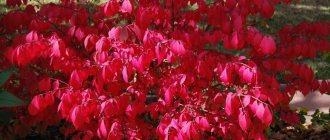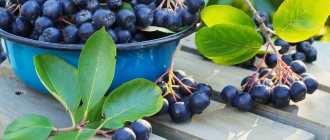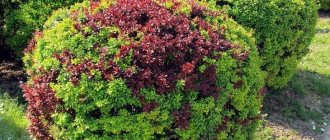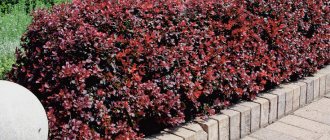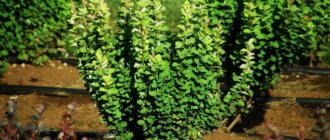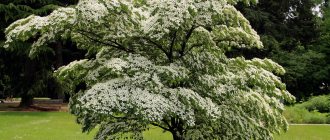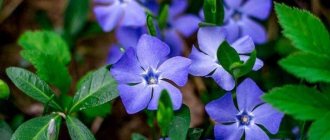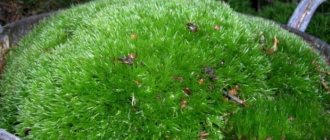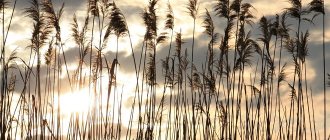Unpretentious shrubs are used to create colorful landscape accents - hedges, solitaire compositions. The medium-sized barberry Thunberg Aurea is characterized by a lemon-yellow crown color. The plant is undemanding to cultivation conditions, so independent planting is possible in a summer cottage or suburban area.
Characteristics
| Height: | up to 120 cm |
| Bush width: | up to 150 cm |
| Stems: | thin, erect, with large spines |
| Leaves: | round, up to 3 cm in diameter. Yellow or yellowish-green in spring and summer, turning orange-yellow in autumn |
| Bloom: | the end of May |
| Flowers: | small, yellow, attracts bees |
| Fruit ripening: | late September-early November, berries stay on the branches for a long time |
| Fruit: | red berries are elongated, up to 1 cm long. |
Features of cultivation
The crop can be propagated by cuttings, dividing the root system, seeds, cuttings and layering. Professional gardeners graft shoots. When working with plants of various types, you need to take into account a number of nuances:
- When forming a hedge, try to maintain the distance between the cuttings. A dense bush wall provides for planting 4-5 crops per 1 meter of length, and a freely growing one - 2 cuttings per 1 m;
- container bushes are replanted with a lump of earth, which is watered abundantly;
- Before sowing grains, stratification is carried out. Seeds should be placed in nylon or cotton cloth and buried in fur or sawdust. The material is stored at temperatures up to +5 degrees from April to May, and then planted in the garden. Autumn planting involves placing the seeds in a 2-3 cm deepening of the soil.
Planting in autumn is carried out after the leaves have fallen, and in spring - after the snow has melted.
Description
Medium spreading bush up to 120 cm high and up to 140 cm in diameter. The stems are mostly vertical and almost vertical, some bend under their own weight. The leaves are small, greenish-yellow in spring, then become light yellow and acquire orange tones in autumn. The foliage lasts almost until snowfall. The flowers are small and almost invisible against the background of yellow leaves.
Application in landscape design
The uses of this spectacular shrub are varied:
- This beautiful, decorative leaf form of barberry can decorate a rocky garden
- Yellow-leaved varieties make magnificent low borders, which are good both in their natural form and in a shaped, trimmed form.
- This shrub looks very good in flower beds; from a distance it looks like a spectacular flowering plant.
- The combinations of different varieties of barberry with yellow, green and purple leaves are very beautiful.
(Visited 83 times, 24 visits today)
Barberry Thunberg "Aurea" - planting and care
Soil requirements: prefers light, moderately fertile, well-drained soils with a neutral or close to neutral pH of the soil solution. Can grow on poor sandy soils. Lighting requirements: Can grow in well-lit areas and partial shade, but prefers partial shade. In direct sun it can “burn” or change color towards green (which in general is not entirely typical, because usually plants, on the contrary, retain their atypical leaf color only in good lighting). Soil moisture requirements: minimum. Thunberg barberry tolerates drought well, but suffers from stagnant waterlogging. Planting time: for bare-root plants, early spring or mid-autumn. Plants with ZCL can be handled throughout the summer. Care: practically not required: plants can be fed once every few years, watered during the most prolonged droughts and pruned. Winter hardiness: high. Tolerates prolonged frosts down to -35. In the conditions of the Moscow region it never completely dies from frost, but in the harshest winters it can freeze above the snow level. Relation to pruning: tolerates pruning well in early spring. They carry out sanitary (frozen and broken shoots are removed), formative and rejuvenating (old branches are cut into stumps) pruning. Diseases and pests: only powdery mildew is significant. It is recommended to use copper-containing fungicides or fungicides designed to control powdery mildew on fruit trees.
How to care
The list of care procedures includes watering, fertilizing, pruning, preparing for winter and disease prevention.
Watering and fertilizing
After planting, Thunberg Aurea barberry is watered generously. Mulch retains moisture and reduces the frequency of watering. In the future, the gardener is only obliged to monitor the condition of the soil and respond in a timely manner, especially in dry weather. If the summer turns out to be rainy, barberry is watered once every 7 days. A bucket of water is poured under each bush.
A year after planting, barberry is fed with nitrogen. 25 g of urea are dissolved in 10 liters of water and poured under the root. The procedure is performed once every 3 years.
After watering, the soil is loosened superficially and the area is mulched if necessary.
Trimming
Shrubs are trimmed 3 years after planting. The procedure is best carried out in the spring. Undeveloped shoots, dry and frozen stems are removed. Sanitary pruning is performed as necessary.
To form a neat crown, decorative pruning is carried out twice a year - in June and August.
The photo below shows the procedure for pruning barberry.
Preparing for winter
Barberry Aurea overwinters without loss, but in the northern regions the bushes are insulated with agrofibre or spruce branches. A shelter from scrap materials is formed with the arrival of frost. Single bushes are wrapped in burlap and tarpaulin and tied with rope.
Diseases, their treatment and prevention
Barberry Thunberg Aurea has a strong immune system, thanks to which the plant rarely suffers from fungal diseases and is not subject to insect attacks. However, the condition of the bushes must be monitored. This makes it possible to identify the disease at an early stage and gives a greater chance of salvation.
The most common diseases of barberry:
- powdery mildew;
- spotting;
- rust on leaves.
The bright leaves are attacked by aphids and sawflies, and the flower moth feasts on the fruits.
Powdery mildew appears as a whitish coating on the foliage. Infected areas are pruned, the bushes are sprayed with fungicides (Fundazol, HOM, Skor). The same products are used to prevent powdery mildew.
Pests are controlled with insecticides (Aktellik, Fufanon, Kinmiks, Karbofos, Iskra). Folk remedies are ineffective.
Reviews
- Moscow region: barberries become greenish in the sun, but in partial shade, on the contrary, they remain yellow until the leaves fall;
- The Moscow region "Aurea" did not grow very well in direct sun and dropped its leaves early. After being moved closer to the wall of the house, it began to grow better;
- Moscow region: “Aurea” burns in the sun, but tolerates winter well;
- Reutov: grows in the shade of other bushes, slowly, but does not get sick;
- Leningrad region: the bush sometimes freezes slightly, but has turned green over the years;
- Krasnodar region: barberry "Aurea" grows in an open area and does not burn;
As you can see, reviews of Aurea barberry are quite contradictory. If you have also dealt with this variety, please leave your feedback in the comments to the article. It will help other gardeners.
And about delicious
Barberry Thunberg Aurea is not only a beautiful ornamental plant, but also bright fruits rich in vitamins. They make jam, marshmallows and candies. Dried berries are brewed and consumed in winter as a tonic drink. Leaves are added to marinades. They give canned vegetables a tart flavor.
If you follow simple rules, the Thunberg Aurea barberry will become a real decoration of the site. And it will serve as a personal sun for its owners for a long time.
Reproduction methods
Vegetative methods are used. Mature plants from four to five years old can be divided. The bush is dug up, cut into two or three parts with a sharp instrument and planted in nutritious soil.
A less traumatic method is cuttings. In autumn, shoots of 12-15 cm are cut from the bush. The lower leaves are removed, the bases are treated with a root formation stimulator. Thunberg barberry cuttings are planted in a mixture of peat, sand and compost. Rooted seedlings are transferred to open ground in the spring.
Propagation by seeds is not carried out. They have low germination rates and germinate very poorly.
Planting a plant
Barberry Thunberg Maria is a very unpretentious plant, however, in order for it to take root on the site, special attention should be paid to planting it in a permanent place.
So, the soil should be loose and fertile, with a low salt content. Bushes can grow in shaded places, but at the same time the decorativeness of their leaves is reduced - the plates become simply green. Bushes can grow in shaded places, but the decorativeness of their leaves is reduced - the plates become simply green.
When planting a plant in the fall, it is important to consider that frosts can be dangerous for young shoots, so they need to be prepared for winter
Planting from seeds
If you already have Maria barberry in your garden plot, there is no need to purchase seedlings. It is enough to simply collect the ripe berries and extract the seeds from them. Afterwards they should be washed thoroughly.
Washed seeds can be treated with potassium permanganate for disinfection.
In order to preserve seeds for spring planting, it is recommended to keep them in the refrigerator or cellar. If autumn work is planned, the seeds can be treated with special growth regulators.
Note! Barberry has a rather poor germination rate - usually from 30 to 35%. Therefore, for a good result, the plantings should be dense. To sow seeds, you need to dig up the ground and prepare the beds
Experienced gardeners note: autumn seeds will sprout only in the spring, and planting material will only be available in about a year and a half to two years.
To sow seeds, you need to dig up the ground and prepare the beds. Experienced gardeners note: autumn seeds will sprout only in the spring, and planting material will only be produced within a year and a half to two years.
Planting seedlings in open ground
At first, barberry Maria grows not in height, but in width
That is why it is important to plant young shoots at a distance of about two meters from each other and from other plants. The size of the hole should exceed the size of the root ball. In order for the plant to take root, the following composition should be added to the planting hole:
In order for the plant to take root, the following composition should be added to the planting hole:
- two parts of turf land;
- one part of humus;
- one part peat.
Before removing the seedling from the container, the soil must be thoroughly watered - this will prevent damage to the rhizome.
The plant is mulched with dry grass or wood shavings
Planting barberry Tunberga Maria looks like this:
- Remove the seedling from the container.
- Place the plant in the prepared hole and carefully straighten the roots.
- Cover the root with soil and compact it without filling the hole completely.
- Water the soil generously.
- Add soil to completely fill the hole.
- Water again.
If there is damage to the roots of the barberry, they must be removed by treating the cut area with a solution of potassium permanganate. Barberry planted on a hot, dry day needs shelter.
Important! Under no circumstances should the growing point be buried - this can lead to the death of the plant. Separately, it is worth mentioning about planting an entire hedge. In this case, experienced gardeners recommend using two-year-old seedlings
In this case, experienced gardeners recommend using two-year-old seedlings
Separately, it is worth mentioning about planting an entire hedge. In this case, experienced gardeners recommend using two-year-old seedlings.
They must be planted as follows:
- Dig a trench 50 centimeters wide and the length required.
- If the soil is poor, add a nutrient composition to the bottom of the trench.
- Plant each plant as described above.
- Protect plants from direct sunlight.
4. Medicinal properties of barberry
Berries are considered the most useful - they have choleretic properties , have a mild laxative effect, stimulate appetite, and serve as an antiseptic.
Barberry berries are also capable of restraining the urge to vomit , and therefore they can be used for motion sickness and during pregnancy, when toxicosis begins. Eating barberry fruits can improve the overall tone of the body and increase its resistance to various diseases.
Antioxidants contained in berry juice can slow down the overall aging of the body and help remove various toxins from it.
For colds, the plant is used as an antipyretic and diaphoretic (for example, a fruit drink is prepared from the berries of the bush); it can liquefy and remove phlegm from the body when coughing.
Tinctures of barberry leaves can relieve internal bleeding and have anti-inflammatory properties.
Decoctions of the plant's flowers help normalize heart function (in particular, they help combat palpitations) and can lower blood pressure.
It is believed that the plant also has analgesic, antispasmodic, and antitumor effects. In addition to its beneficial properties, the plant has many contraindications , so before using it you should consult your doctor.
↑ Up,
In addition to traditional medicine, barberry has also found its use in cosmetology - it is believed that the juice of the plant can smooth out small wrinkles and restore skin tone, promote hair growth and strengthening, and help get rid of dandruff.
↑ Up,
Barberry Koronita - decoration and protection of the garden
You can use shrubs on your site in various variations and compositions. This plant involuntarily attracts the eye with its unusually bright attire. The density of foliage and thorns will become an impassable barrier in a few years. Therefore, placing seedlings along the fence will provide natural protection for the area from winds and unwanted guests. It is necessary to plant plants lengthwise along the fence in close proximity to each other. The originality of barberry is also manifested in its plasticity.
By pruning and forming a bush, you can create attractive compositions that will decorate the area
Preparing for winter
At the very end of autumn, water your Thunberg barberries generously and mulch the soil around each plant with peat neutralized from the AGRO line with a layer of 8-10 cm per radius of 0.8 m
For the winter, cover the bushes with special light-transmitting, but not wet, fabrics in 2 layers, this is especially important for 1-2-year-old specimens. Secure the voluminous Thunberg barberry bushes with twine so that the snow mass does not break their shapes
Securely secure the covering material to the ground so that it adheres tightly to the mulch.
Alternatively, you can make cylinders around Thunberg barberry bushes under 5 years old from a metal/plastic mesh 10 cm higher than the height of the bushes, fill the space between the plants and the mesh to the top with dry leaves, cover each cylinder with plywood on top and wrap it with lutrasil (the so-called “ bar"). Secure the outside of each cylinder to the ground to prevent it from being knocked over by the wind. Adult bushes of Thunberg barberry older than 5 years can not be covered, but only mulched and tied to preserve their shape from the effects of snow mass.
Landscape possibilities
The spectacular color of the crown of the Admireish variety justifies its use for decorating areas. The shrub is planted at the dacha, in the garden and park area, near the coastline of water bodies. The small size of the bush contributes to the following planting options:
- tapeworm. A single red-leaved plant will complement an assemblage of dwarf conifers and deciduous trees with a dense crown (arborvita, spruce, spirea);
- rock garden element. In combination with boulders above 0.5 and rock fragments it creates the effect of a natural alpine slope;
- border. Geometric lines of barberry bushes will serve as a beautiful frame for flower beds, paths, memorials, historical sites and alleys;
- array. The square-nest planting method will allow you to create a bright replacement for standard flower beds and ridges.
The labor costs for arranging barberry compositions will be repaid by the spectacular appearance of the site. With proper care of the plant, you can get an excellent addition to your garden plot in the form of a picturesque dwarf shrub with an unusual appearance.
- https://www.ogorod.ru/ru/outdoor/trees/13678/10-sortov-barbarisa-kotorye-ukrasyat-vash-sad.htm
- https://idachi.ru/sad/dekorativnie/barbaris-admirejshn.html
- https://fermilon.ru/sad-i-ogorod/kustarniki/barbaris-tunberga-admireyshn-admiration.html
- https://stroy-podskazka.ru/barbaris-tunberga/opisanie/
- https://stroy-podskazka.ru/barbaris-tunberga/golden-ring/
- https://m-strana.ru/design/barbaris-kustarnik-posadka-i-ukhod-dekorativnye/
- https://stroy-podskazka.ru/barbaris-tunberga/admirejshn/
- https://7ogorod.ru/plodovye-kusty/barbaris-admirejsn.html
Other common varieties
There are a huge number of types of barberry. They can have green, yellow, orange and red leaves.
Important! It is recommended to select seedlings for the garden only in trusted places to be sure of the desired shade. Common plant varieties include:
Common plant varieties include:
- Green carpet is a low and dense shrub with bright green leaves. Closer to autumn they change their color to orange. At the end of the summer months the bush stands completely covered with bright red berries. In landscape design it is used as a ground cover;
- Maria is a low shrub with long yellow leaves. By autumn their color changes to bright coral. Barberry berries are very large, up to a centimeter in diameter. The variety is not afraid of frost and drought.
The Harlequin variety with magnificent variegated leaves will be an excellent decoration for the site. They are red and covered with white, gray and pink spots on top. The shrub is suitable for creating a variety of flower arrangements in the garden.
Variety Green carpet
Diseases and pests
Barberry "Rose Glow" does not tolerate dampness, so it can be susceptible to fungal diseases. Common ailments include powdery mildew, rust and spotting. The use of copper-containing fungicides will help cope with diseases.
The variety often suffers from bark necrosis and bacteriosis.
In the first case, removing diseased shoots and treating with a solution of copper sulfate helps, in the second, cutting off the damaged areas, and if the base of the shoots is damaged, the entire bush.
The most dangerous pest is the barberry aphid.
Insecticides and preventive treatment of bushes with a solution of laundry soap will help cope with it. When attacked by moths, the bushes are treated with Chlorophos, 2% Karbofos or Fitoverm.
Atropurpurea Nana
Flower growers usually shorten the name of this species and pronounce it as Nana barberry. This is a dwarf barberry with a flat-rounded crown, which grows very slowly, and in a year grows no more than 10 cm in height and 15 cm in width, and even less in poor, dry soils. The absolute size is 60 cm in height and approximately 1 m in width. The inner side of the flower is yellow, the outer side is red.
It blooms for a short time - 10-15 days, and the growing season lasts from the beginning of May to the end of September. The leaves of the low-growing barberry change color depending on the temperature: in summer they are dark, purple-red, and in autumn they are rich red.
It is better to plant in a well-lit place, but if this is not the case, the bush will easily tolerate light shade. Barberry Nana has high frost resistance and a strong love for well-moistened soils. The plant looks especially beautiful during the flowering period and when the leaves change color in early autumn.
Barberry varieties
Not everyone can withstand the harsh Russian climate. Among the cold-resistant varieties, there are a number of the best varieties of barberry that are worthy of the attention of amateur gardeners. After reading their descriptions, it is easier to choose the most suitable one for certain conditions.
According to the botanical description, common barberry is a prickly shrub from the Barberry family, reaching a height of 1.5 - 3 m. There are also dwarf species of the plant. The branches are long with spines up to 2 cm. The leaves are thin and narrowed near the petiole, with a darker upper side. By autumn they become brightly fiery. The barberry bush looks very beautiful during flowering (May-June). Small light yellow flowers, collected in brushes, bloom on the branches. Red sour fruits are collected and stored in the fall (September - October).
Barberry "Ottawa Superba". As the name suggests, this is a Canadian barberry. Quite a large shrub, reaching a height and width of 3-4 meters. The bark is red-brown, the leaves are shiny, dark red or purple, and look impressive all season long. In autumn the foliage turns orange or pale red. It blooms in May with yellow-red racemose inflorescences with a pleasant sweetish aroma.
Barberry "Golden Ring". Also a tall shrub. At the age of 10 years it can reach 2.5 meters in height and 3 m in width. The variety tolerates temperate climates well. Designers value this variety of barberry for the special color of its leaves. In summer they are dark red, and in autumn they turn burgundy, purple and orange, and the older the bush, the stronger the color. Another feature due to which the variety got its name is the yellow edging of the leaves, similar to a golden ring. It appears only in the third year of life.
Barberry "Admiration". It is rightfully considered one of the most attractive varieties of barberry. It was developed not so long ago, and many gardeners still do not know about it. This variety of barberry is classified as low-growing - it grows no more than 30-40 cm in height. The crown is dense, cushion-shaped or spherical. The leaves are small and spatula shaped. The shade depends on the lighting and location of growth; it can be reddish-brown, beetroot or bright red. The main advantage is the golden border, like the “Golden Ring”, but the “Admiration” has a more stable border, and the crown is dense and miniature.
Barberry "Aurea". Its main difference from other barberry varieties is the unusual bright lemon-yellow color of the leaves. In addition, it is compact, does not require special planting and maintenance conditions, is not affected by rust, powdery mildew, and can withstand urban polluted environments and the vagaries of the weather (strong wind, rain, drought).
It reaches a height of 80 cm, and the crown grows up to 1.5 m in width, although it grows very slowly. Bushes can be trimmed to give them the desired shape.
Barberry "Harlequin". It reaches 1.5-2 m in height and width. The variety is valued by designers for its branched crown with a non-standard purple tint of leaves with small gray or white specks. Summer sun turns the foliage white, while autumn cold turns it red, amber or gold. Its berries are inedible, like those of other ornamental varieties, but they decorate the bush all winter.
Barberry "Orange Rocket". Also an unpretentious compact shrub - no more than 1.5 meters high and 50 cm wide. It grows poorly in the shade and loses leaf color, but is not demanding of moisture and temperature. Lives up to 50 years.
Barberry "Erekta". This is a tall bush (1.5 m) with green leaves and columnar straight shoots directed upward. The variety is distinguished by a small number of spines and fairly dense leaves. It blooms at the very beginning of summer with beautiful flowers with a pleasant aroma.
Red-leaved barberry combines several varieties that are similar in leaf color. It can be:
- dwarf;
- tall;
- medium-sized.
The first include “Atropurpurea nana” and “Bagatelle”. The second group includes “Red Carpet” and “Red Lady Darts”, and the third group includes “Golden Ring”, “Red Pillar” and “Red Chief”.
Among the decorative deciduous varieties suitable for cultivation in our conditions, we can highlight, for example:
- "Golden Rocket";
- "Rosie Rocket";
- "Ottawa Auricom";
- Red Jewel;
- "Golden Ruby";
- "Ruby Star";
- "Rose Glow"
Today, barberry varieties are presented on the market to suit every taste. Thanks to this, a lot of opportunities open up for using them in the design of the site and garden landscaping. The bushes look good both as hedges, garden compositions, and alone.
We suggest reading about how to properly plant barberry and care for it here.
I like it I don't like it
And if you have something to share, leave your comments! Your feedback is very important to us!
Advantages and disadvantages of the variety
The Aurea shrub has become popular among gardeners due to its unpretentiousness and decorative qualities. The plant is in many ways superior to other varieties of Thunberg barberry.
Shrub life expectancy – up to 60 years
Advantages of the variety:
- decorativeness;
- winter hardiness;
- low sensitivity to diseases;
- high drought resistance;
- love of light.
Flaws:
- slow growth of branches;
- short-term flowering;
- sensitivity to shading.
How to plant: step-by-step instructions
Even before planting a seedling, it is necessary to take into account recommendations for choosing a site for this garden crop. The place should be well lit and open. It is advisable that it be protected from cold winds from the north side
It is important to consider that varieties with green foliage can grow in partial shade or lacy shade. But varieties with yellow or red leaves really need good lighting
Even in slightly shaded areas, these types of Thunberg barberry will not grow well.
Choosing a good seedling is already half the battle
Be sure to pay due attention to this process. Buy planting material from nurseries, specialized stores selling gardening plants, or from trusted sellers
It is advisable to buy seedlings with a closed root system; they are easier to plant and take root quickly. When choosing, carefully examine the young plant. There should be no mechanical damage, creases or obvious signs of disease on its branches. Ask the seller to make an extreme cut of one of the shoots. If the seedling is healthy and alive, then the cut site will have a greenish tint. In dry seedlings it is brownish. The root system also deserves special attention. It should contain a large number of small (fibrous) roots.
Barberry can be planted both in spring and autumn. However, autumn planting must be completed at least three weeks before the onset of freezing temperatures.
In central Russia, the deadline for planting seedlings is mid-October. In the north it is better to plant barberry in the spring. Otherwise, the plants may not get stronger before the cold weather and risk freezing in the first winter.
The pit for barberry must be prepared in advance. For spring planting, it is advisable to dig it up in the fall. But if there was no time to do this in the fall, then in the spring the planting hole is prepared at least two weeks before planting. The pit is made quite deep and wide - 70 by 70 centimeters. If the soil on the site is poor, it is recommended to add humus or turf substrate. Barberry is an unpretentious crop, but it does not like heavy and clayey soils. And also mineral fertilizers are added to the pit - 50 grams of urea (it can be replaced with ammonium nitrate), 50 grams of potassium and 50 grams of phosphorus. All this is mixed well with humus.
The seedling is carefully placed in the hole, straightening its roots in different directions.
It is important not to cut off the roots, otherwise the plant will take a long time to take root and become sick. Then the root system is covered with soil, a trunk circle is made and watered
It is recommended to pour one bucket of water onto each planted plant. As the water is absorbed, the tree trunk circle is mulched. You can use straw, sawdust, shavings, humus or grass as mulch. Mulch will retain moisture in the soil for a long time. As a result, you will not have to water the young plant often.
And another important point is the distance between the bushes. Barberries need to be planted at a distance of one and a half meters from each other and at the same distance between the rows. However, if you want to form a hedge out of it, then the distance between the bushes is reduced. In this case, barberry bushes are planted at a distance of 50–70 centimeters from each other.
Useful properties of the culture
The plant attracts not only its decorative effect. It has long been known for its taste and healing properties. Common barberry is mainly used for medicinal purposes. Its berries are used to make various culinary dishes (compotes, jelly, jelly), and added to vegetables, meat, and rice. The berries contain useful acids, the leaves contain vitamins C, E, and carotenoids. Various parts of the plant are useful.
Barberry remedies help with:
- increased blood pressure;
- inflammation of the gallbladder;
- hepatitis;
- psoriasis;
- pancreatitis;
- high temperature;
- bleeding;
- eczema and other ailments.
Unripe barberry fruits are poisonous. Therefore, they need to be collected only after ripening. After collection, they are dried and stored in a dry place for no more than 3 years.
Barberry is a picky garden crop that will look spectacular on any site. In addition to bright decorative foliage, some species are grown to produce tasty, healthy fruits. Planting and growing barberry is not difficult; anyone can decorate their area with shrubs.
Do you want to know more useful information about growing Barberry on your site? Watch the video:
